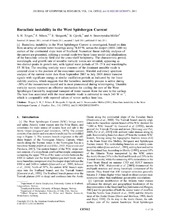| dc.contributor.author | Teigen, Sigurd Henrik | eng |
| dc.contributor.author | Nilsen, Frank | eng |
| dc.contributor.author | Skogseth, Ragnheid | eng |
| dc.contributor.author | Gjevik, Bjørn | eng |
| dc.contributor.author | Beszczynska-Möller, Agnieszka | eng |
| dc.date.accessioned | 2012-01-11T14:34:19Z | |
| dc.date.available | 2012-01-11T14:34:19Z | |
| dc.date.issued | 2011-07-15 | eng |
| dc.identifier.issn | 0148-0227 | en_US |
| dc.identifier.uri | https://hdl.handle.net/1956/5404 | |
| dc.description.abstract | Baroclinic instability in the West Spitsbergen Current is investigated, based on data from an array of current meter moorings along 78.83oN, across the deeper (1000-2400 m) section of the continental slope west of Svalbard. Numerical linear stability analyses of the current are presented, utilizing a normal mode two-layer linear model and idealizations of the baroclinic velocity field and the cross-shelf bathymetry. The characteristic period, wave length, and growth rate of unstable vorticity waves are revealed, appearing as two distinct peaks in growth rate, with typical wave periods of 35-75 h and wave lengths 15-30 km. The resulting vorticity wave structure of the dominant unstable mode is centered close to the position of the maximum current. Wavelet and rotary spectrum analysis of the current meter data from September 2007 to July 2009 detect transient signals with significant energy at similar oscillation periods as indicated by the linear stability analysis, which suggests that the baroclinic instability process is active during ∼ 30% of the measurement record and is most pronounced during winter/spring. Unstable vorticity waves represent an effective mechanism for cooling the core of the West Spitsbergen Current by isopycnal transport of water masses from the core to the surface. The heat loss associated with the most unstable mode is estimated to reach 240 W/m2, which is comparable with reported values of winter surface heat loss. | en_US |
| dc.language.iso | eng | eng |
| dc.relation.ispartof | <a href="http://hdl.handle.net/1956/5406" target="blank">Water mass exchange in the sea west of Svalbard. A process study of flow instability and vortex generated heat fluxes in the West Spitsbergen Current</a> | en_US |
| dc.title | Baroclinic Instability in the West Spitsbergen Current | en_US |
| dc.type | Peer reviewed | |
| dc.type | Journal article | |
| dc.description.version | publishedVersion | en_US |
| dc.rights.holder | Copyright (2011) American Geophysical Union | en_US |
| dc.source.articlenumber | C07012 | |
| dc.identifier.doi | https://doi.org/10.1029/2011jc006974 | |
| dc.identifier.cristin | 841422 | |
| dc.source.journal | Journal of Geophysical Research – Oceans | |
| dc.subject.nsi | VDP::Mathematics and natural science: 400::Geosciences: 450 | en_US |
| dc.subject.nsi | VDP::Mathematics and natural science: 400::Geosciences: 450::Oceanography: 452 | en_US |
| dc.identifier.citation | Journal of Geophysical Research – Oceans 116: C07012 | |
| dc.source.volume | 116 | |
| dc.source.issue | C7 | |
